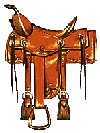|
Western Saddle Seat Size and Shape
|

|
Saddle seat size isn't the whole issue here - there are other things of take into account.
Requirements For A Good Fit
To ensure a good fit for the rider in the western saddle you want to take into account the size of the seat, the shape of the seat, stirrup length and rigging.
Proper seat size and shape are determined by the intended use of the saddle.
Seat Shape The ultimate shape or contour of the saddle, as we observe it (and feel it) is determined by the shape of the "ground seat" which is the part of the seat you don't see.
The ground seat is built up on the tree and usually consists of several layers of leather contoured to the desired shape which is a function of the saddle's intended use.
If you're purchasing a barrel racing saddle or a trail saddle you would get a deeper seat than say for a reining saddle. The shape would move your weight more towards the rear.
A cutting saddle is flatter allowing the rider to adjust easily to the horse's (sometimes violent) movements.
A roping saddle will usually have a lower cantle allowing the roper to dismount quickly (every fraction of a second counts).
- and so on.
Rigging is also tied to the intended use of the saddle.
Most folks will find 7/8 rigging very comfortable with the only question whether to go single or double rigging. Click on "Rigging " above if you are looking for more information on this aspect of saddle fit and design.
Stirrup length is generally a no-brainer since the length will generally be adjustable to fit the rider's needs.
Which leads us to -
 Seat Size - Fortunately, seat size isn't quite as critical as fit to the horse or hat size or boot size. Obviously a seat that is way to big will not feel as secure and one too small will begin to be uncomfortable after not too many hours (or minutes) in the saddle.
Seat Size - Fortunately, seat size isn't quite as critical as fit to the horse or hat size or boot size. Obviously a seat that is way to big will not feel as secure and one too small will begin to be uncomfortable after not too many hours (or minutes) in the saddle.
But we can offer some guidelines which generally serve pretty well. If in doubt go to the next highest size (sizes usually increase in 1/2 inch increments) and the saddle should still be comfortable.
In General:
-
Youngsters into the pre-teens would use a 13" or 14" seat. A petite adult female might fit a 14" seat but it's better to be a little too large so 15" might be better.
- Most women will find the 15" (weight 110 - 140) or 16" seat (weight 140- 170) most comfortable.
- For men up to 150 lbs go with a 15" seat, 16" for a weight range of 150 to 180 lbs. and a 17" for weights up to and over 200 lbs.
- If you weigh over 230# for men or over 210 lbs for women we're talking about an 18" seat.
The above guidelines will normally suit most saddle buyers purposes. I would only note that nothing is set in concrete, that you or your horse lover may have a reason to deviate somewhat from the examples given.
A team roper for example will often use a seat an inch or so longer for roping events than he or she would for trail riding to get a little additional clearance between the hands and the saddle horn while a tie-down (calf) roper may want a smaller than normal seat where the thighs are nearly in contact with the fork/swell.
A novice rider may prefer a saddle slightly shorter than "standard" to be closer to the fork/swell for an added sense of security.
The best advice is to sit in the saddle before purchasing it (when possible) and judge for yourself if it meets your requirements for comfort, security, movemnet, etc..
When I'm seated comfortably the closest my leg is to the fork/swell is 1-1/2 inches and my belt buckle is about 4 inches from the fork/swell.
Like with shoe sizes, it's better to have a seat size that's a bit too large than too small. If the seat has sufficient dip the rider can find proper balance. A flatter seat that's too long would make this difficult. Put another way, if a 16" saddle is the right fit, a 17" might still be OK while a 15" would not feel right.
